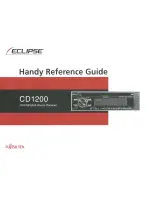
Supported Alteia Protocol Commands and Messages
2. Commands requesting component information have the following format: \
000:ENQ;CCC=hhhh_$FFCr where CCC represents the sub-command for the specific
component type, and hhhh is an index into the list of components of that type, range
0000h to 0063h. The reply format is: \000:ENQ;CCC=hhhh,hhhh,ccccccc_$FFCr
where the first field is a copy of the index supplied by the command, the second field is
the component PID, range 0000 to 1FFF; and the last field is a 7 character ASCII text
component description. Where a request is made for a component that is not present
in the service, the return will be: \000:ENQ;CCC=hhhh,FFFF, _$FFCr
3. Command is \000:ENQ;FAV=dd_$FFCr where field is favourite service slot number,
range 00 to 39. Reply is \000:ENQ;FAV=dd,c…c_$FFCr where first field is a copy of
the favourite service slot number supplied by the command. The second field c….c is
a 30 character string containing the name of the favourite service stored in that
favourite service slot (truncated or padded with trailing spaces as required, no null
termination). Where there is no favourite service stored in that slot the text “NO
STORED SERVICE” (with appropriate padding spaces) will be returned for favourite
service name.
4. Command is \000:ENQ;SER=dd_$FFCr where field is service number, range 00 to 99.
Reply is \000:ENQ;SER =dd,c…c_$FFCr where first field is a copy of the service
number supplied by the command. The second field c….c is a 30 character string
containing the name of the service (truncated or padded with trailing spaces as
required, no null termination). Where the supplied service number exceeds the number
of services present in the transport stream the text “No Service” (with appropriate
padding spaces) will be returned for service name.
5. Command is \000:ENQ;SE2=dd_$FFCr where field is service number, range 00 to 99.
Reply is \000:ENQ;SE2 =dd,ddddd,ddddd,ddddd,c…c_$FFCr where first field is a
copy of the service number supplied by the command. The second field is the program
number. The third field is the major channel number. The fourth field is the minor
channel number. The last field c….c is a 30 character string containing the name of
the service (truncated or padded with trailing spaces as required, no null termination).
Where the supplied service number exceeds the number of services present in the
transport stream the values 0 and text “No Service” (with appropriate padding spaces)
will be returned for service name.
6. Command is \000:ENQ;SRQ_$FFCr. Reply is \000:ENQ;
AUD=hhhh_VID=hhhh_PCR=hhhh_LSD=hhhh_OP1=hhhh_OS1=hhhh_OP2=hhhh_O
S2=hhhh_HSD=hhhh_ETH=hhhh_AU2=hhhh_AU3=hhhh_AU4=hhhh_AU5=hhhh_AU
6=hhhh_TTX=hhhh_$FFCr where fields are the current PIDs for the components as
follows:
AUD audio 1 component
VID video component
PCR PCR component
LSD async data
OP1 not used
OS1 not used
OP2 not used
OS2 not used
HSD sync data
EHD Ethernet HSD
AU2 audio 2 component
TTX teletext
PIDs are given as hex values, range 0000h to 1FFFh. A returned value of FFFFh
indicates no PID is selected for that component. OP1, OS1, OP2, and OS2 (System
32 (59)
Document No. ST.TS.EXXXXX.1 2010-03-04
















































